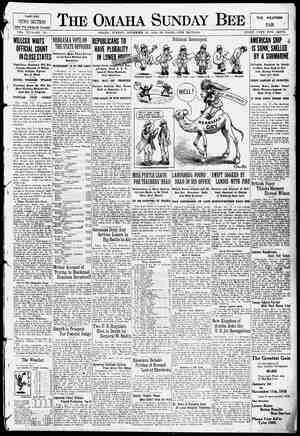Omaha Daily Bee Newspaper, November 12, 1916, Page 19
You have reached the hourly page view limit. Unlock higher limit to our entire archive!
Subscribers enjoy higher page view limit, downloads, and exclusive features.
e I Fyses; i heey HE OMAHA SUNDAY BEE MAGAZINE, PAGE by the Tovember 12, 1916=, . sram"" dressed women. that centre of fashion. W Fc'lS‘hiOnS that India InSPired 2 ' ADY DUFF-GORDON, the famous “Lucile” of London, and, foremont creator of fashions in the world, wriles each week the fashion article for this newspaper, presenting all that is newest and best in atyles for well- Lady Duff-Gordon's Paris establishment brings her fnio close. touch with Lady Duf-Gordon's American_ establishments are at 37 and 39 West Fifty-seventh street, New York, and .1400 Lake Shore Drive, Chicago, \ By Lady Duff-Gordon ("LUCILE”) O create exterior forms that invoke the persistently T haunting charm of mystery deflnes the ages-old genius of Indla. In all its art, architecture, litera- ture, music, religion and in the draping of the lithe, dark bodles of young Hindus a single governing theme is crystalized—the haunting beauty of mystery. For a long, long while I have sought to grasp that elu- sive secret and weave it into drapings and adornments for our Western beauty types that should grace their natural superior advantages with the added peculiar fascination that is India. Now, at last, I hopefully pre- sent a result that is {llustrated on this page. The general effect is what is important. Does it breathe the spirit of India? I feel that it does. In detail of Silver Brocade, With Underskirt of Gold O Colored Tissue An Indian Model Tea Gown it is a matter of adapting characteristic forms and mate- rials. The headdress is not an Indtan turban. But with 1ts shades of mauve and pink satin, its garland of flowers and its surmounting spike of green, diamond-jewelled, certainly it suggests Indla at first sight. Necessarily it is an adaptation. A new mode cannot be literally faithtul to the object which inspired it. Thus, too, the vine and fur-bordered embroidered coat suggests the long and graceful scarves worn by Hindu princesses. Observe how it is fashioned to appear as though wound about the body, leaving openings of gauze through which is revealed the close swathing of the robe about the knees—another characteristic Indian touch. The flaring amplitude of the robe downward from the coat's fur border is designed to accentuate that Hindu slimness of the figure at the knees. 1t is not reasonable to expect our women of fashion to learn to drape their bodies with unshaped fabrics. 8o here the problem for the Western costumer is to apply her art 80 as to supply definite garments which appear to be simple draperies, and indicate the inherens ability. of Hindu women to ignore the.oconveniences of seams and buttons. The tea gown fllustrated here is of silver brocade on gray chiffon. The underskirt is of gold colored tissue edged with Orfental flowers. The collar, cuffs and edge of the coat are of brown fox. The underskirt is a shot marquosette of green and pink, edged with heavy lead to hold down the train. This Indian style 18, of course, best adapted to the girl or very slender woman. With that restriction it is my most novel conception for the coming season. The Turban in Mauve and Pink Satin, With a' Jewelled Green Spike wnd Garland of Flowers
